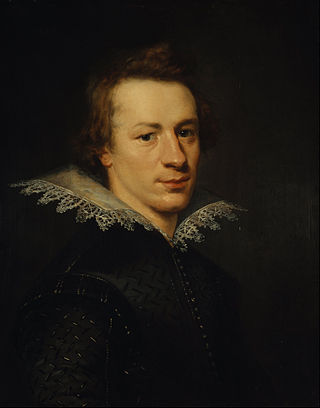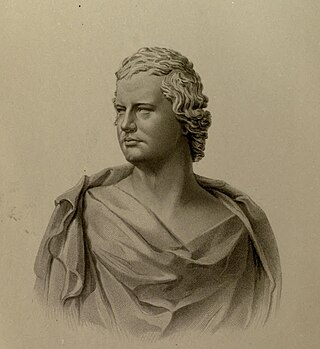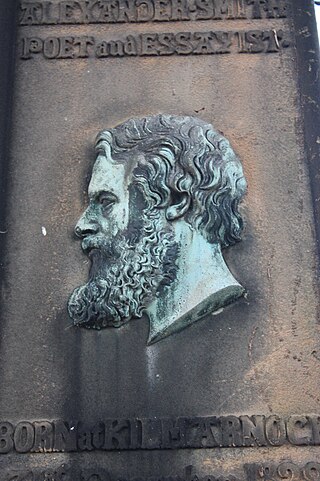Related Research Articles

Sir Thomas de Ercildoun, better remembered as Thomas the Rhymer, also known as Thomas Learmont or True Thomas, was a Scottish laird and reputed prophet from Earlston in the Borders. Thomas' gift of prophecy is linked to his poetic ability.

William Drummond, called "of Hawthornden", was a Scottish poet.

William Edmondstoune "W. E." Aytoun FRSE was a Scottish poet, lawyer by training, and professor of rhetoric and belles lettres at the University of Edinburgh. He published poetry, translation, prose fiction, criticism and satire and was a lifelong contributor to the Edinburgh literary periodical Blackwood's Magazine. He was also a collector of Scottish ballads.

The Child Ballads are 305 traditional ballads from England and Scotland, and their American variants, anthologized by Francis James Child during the second half of the 19th century. Their lyrics and Child's studies of them were published as The English and Scottish Popular Ballads. The tunes of most of the ballads were collected and published by Bertrand Harris Bronson in and around the 1960s.

Alexander Smith was a Scottish poet, labelled as one of the Spasmodic School, and essayist.
The Percy Folio is a folio book of English ballads used by Thomas Percy to compile his Reliques of Ancient Poetry. Although the manuscript itself was compiled in the 17th century, some of its material goes back well into the 12th century. It was the most important of the source documents used by Francis James Child for his 1883 collection The English and Scottish Popular Ballads.

"Sir Patrick Spens" is one of the most popular of the Child Ballads, and is of Scottish origin. It is a maritime ballad about a disaster at sea.
Jane Colden was an American botanist, described as the "first botanist of her sex in her country" by Asa Gray in 1843. Although not acknowledged in contemporary botanical publications, she wrote a number of letters resulting in botanist John Ellis writing to Carl Linnaeus of her work applying the Linnaean system of plant identification to American flora, for which botanist Peter Collinson stated "she deserves to be celebrated". Contemporary scholarship maintains that she was the first female botanist working in America, which ignores, among others, Maria Sibylla Merian or Catherine Jérémie. Colden was respected as a botanist by many prominent botanists including John Bartram, Peter Collinson, Alexander Garden, and Carl Linnaeus. Colden is most famous for her untitled manuscript, housed in the British Museum, in which she describes the flora of the Hudson Valley in the Newburgh region of New York state, including ink drawings of 340 different species.
Willie's Lady is Child ballad number 6 and Roud #220. The earliest known copy of the ballad is from a recitation transcribed in 1783.

The Heir of Linne is a traditional folk song existing in several variants.
"Willie's Lyke-Wake" is Child ballad 25.
Lord Maxwell’s Last Goodnight is Child ballad 195. It is based on the actions of John Maxwell, 9th Lord Maxwell, who killed Sir James Johnstone in 1608 as the culmination of a family feud. He fled to France and was sentenced to death in his absence, returning in secret five years later. He was apprehended and beheaded at Edinburgh on 21 May 1613.
"The Maid and the Palmer" is an English language medieval murder ballad with supernatural/religious overtones. Because of its dark lyrics, the song was often avoided by folk singers. Considered by scholars to be a "debased" version of a work more completely known in European sources as the Ballad of the Magdalene, the ballad was believed lost in the oral tradition in the British Isles from the time of Sir Walter Scott, who noted a fragment of it having heard it sung in the early years of the nineteenth century, until it was discovered in the repertoire of a living Irish singer, John Reilly, from whom it was collected in the 1960s, although subsequently other versions have surfaced from Ireland from the 1950s to the 1970s; an additional full text, collected and notated in around 1818, was also recently published in Emily Lyle's 1994 Scottish Ballads under the title "The Maid of Coldingham", having remained in manuscript form in the intervening time. Based on a tape of Reilly's performance provided by the collector Tom Munnelly, the singer Christy Moore popularised the song under its alternate title "The Well Below the Valley" with the Irish folk band Planxty and later solo performances/recordings, this song providing the title of that group's second album released in 1973; the song has subsequently been recorded by a number of more recent "folk revival" acts.
Mary Seton (1542–1615) was a Scottish courtier and later a nun. She was one of the four attendants of Mary, Queen of Scots, known as the Four Marys. She was a sister at the Convent of Saint Pierre les Dames in Reims at the time of her death.
"The Battle of Otterburn" is a Scottish ballad, catalogued as Child Ballad 161, Roud 3293. It is an account of the Scottish victory at the Battle of Otterburn in 1388. This battle also inspired "The Ballad of Chevy Chase", an English version, but the Scottish version is more historically accurate.
Queen of Elphame or "Elf-hame", in the folklore belief of Lowland Scotland and Northern England, designates the elfin queen of Faerie, mentioned in Scottish witch trials. In ballads and contemporary texts, she is referred to as Queen of Elphane, Elphen, or the Fairies. She is equivalent to the Queen of Fairy who rules Faërie or Fairyland. The character as described in witch trials has many parallels with the legends of Thomas the Rhymer and Tam Lin.

MS 1467, earlier known as MS 1450, is a mediaeval Gaelic manuscript which contains numerous pedigrees for many prominent Scottish individuals and clans. Transcriptions of the genealogies within the text were first published in the early 19th century and have ever since been used by writers on the clan histories. The 19th century transcriptions and translations from the manuscript have long been considered inadequate; yet there is no modern, scholarly edition of the manuscript.
Emily Lyle is a Scottish ballad scholar and senior research fellow in the School of Celtic and Scottish Studies at the University of Edinburgh.
Elizabeth Jane Ross was a Scottish poet, artist, and collector of Gaelic music.

The Glenriddell Manuscripts is an extensive collection written in holograph by Robert Burns and an amanuensis of his letters, poems and a few songs in two volumes produced for his then friend Captain Robert Riddell, Laird of what is now Friars Carse in the Nith Valley, Dumfries and Galloway. The two volumes of the manuscript were handsomely bound in calf leather. The first volume of poems and songs was completed by April 1791 and was presented to Robert Riddell, however their friendship ceased due to the unfortunate 'The Rape of the Sabine Women' incident and Robert Riddell died shortly after before any reconciliation could take place. The first volume is partly in Burns's hand with one main amanuensis contributing much of the text in a far neater hand than the author himself and a possible third person contributing to the text. The second volume is entirely in Burns's hand.
References
- ↑ This letter is bound in at the beginning of the 1859 MS, currently in the possession of the University of Edinburgh
- ↑ This is contained within the 1872 manuscript, housed in the Houghton Library, Harvard University, 25241.17*
- ↑ Contained within the Harris Letters, no. 3."Letters and papers relating to the Harris MS", Houghton Library, Harvard University, 25241.41*
- ↑ This information is contained in Child MSS: 33 vols. Houghton University Harvard University, 25241.47*, nos 1726-7
- ↑ This letter is annotated as Harris Letters no. 6
- ↑ Harris Letters no. 6
- ↑ Harris Letters, no.
- ↑ J D Reppert, F J Child and the Ballad, containing a list of 1104 items of correspondence between Child and Macmath. no. 52. This was a PhD thesis, Harvard University, copy held in School of Scottish Studies library, University of Edinburgh
- ↑ The Song Repertoire of Amelia and Jane Harris, Scottish Text Society, pp. xxx-xxxi
- Emily Lyle, Anne Dhu McLucas and Kaye McAlpine (editors) (2002) The Song Repertoire of Amelia and Jane Harris. The Scottish Text Society, 4th series, 30. ISBN 1-897976-17-8
- A CD of the Songs of Amelia and Jane Harris, sung by Katherine Campbell, was produced in 2004 by Springthyme Records.